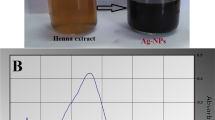Abstract
A proteinaceous glycopeptide was isolated from the posterior salivary gland (PSG) of Sepia pharaonis by gel (Sephadex G-100) filtration chromatography and purified by reversed-phase high-performance liquid chromatography (RP-HPLC). Among the collected fractions, fraction 12 showed a retention time (RT) of 31 min. The total protein and neutral sugar contents of the purified glycopeptide were recorded as 68.14 and 2.95 mg, respectively. The molecular weight of the purified glycopeptide was found to be ~50 kDa. The infrared (IR) and circular dichroism (CD) spectroscopy confirmed the presence of peptide and secondary structure in the purified glycopeptide. The antibacterial activity of the purified glycopeptide against avian bacterial strains was also determined. Gas chromatography-mass spectrometry (GC-MS) of the purified glycopeptide revealed the likely compounds for the antibacterial activity such as 22, 23-dibromostigmasterol acetate, 3-methyl 2-(2-oxypropyl) furan, and 2,4,4-trimethyl-3-hydroxymethyl-5A-(3-methyl-but-2-enyl)-cyclohexene. These three compounds found in the purified glycopeptide could be responsible for the antibacterial activity against the avian pathogens. The results of this study suggest that the purified glycopeptide from the PSG of S. pharaonis could be an antibacterial agent against avian bacterial pathogens.








Similar content being viewed by others
References
Doyle, M. E. (2006). Veterinary drug residues in processed meats—potential health risk, http://fri.wisc.edu/docs/pdf/FRIBrief
Chai, N. (2009). Proceedings of the 4th International Baytril Symposium (pp. 44–– 61). Italy: Florence.
Converse, K. A. (2007) In N. J. Thomas, D. B. Hunter, & C. T. Atkinson (Eds.), Infectious diseases of wild birds. Blackwell Publishing, Ames, Iowa, USA. pp. 289-302.
Michelle, B. R., Jennifer, A., Waldoch, J., Pittman, M., Mark, G., Papich, B., & Hartup, K. (2004). Journal of Avian Medicine and Surgery, 18(3), 144–150.
Centre for Health Protection, (2011). Safe use of antibiotics, http://chp.gov.hk/en/view_content/22878.html.
Saravanan, R., & Shanmugam, A. (2011). Carbohydrate Polymers, 86, 1082–1084.
Ueda, A., Nagai, H., Ishida, M., Nagashima, Y., & Shiomi, K. (2008). Toxicon, 52, 574–581.
Ebada, S. S., Edrada, R. A., Lin, W., & Proksch, P. (2008). Nature Protocols, 3(12), 1820–1831.
Key, L. N., Boyle, P. R., & Jaspars, M. (2002). Toxicon, 40(6), 677–683.
Bradford, M. M. (1976). Analytical Biochemistry, 72, 248–254.
Dubois, M., Gillas, K. A., Hamilton, J. K., Robers, P. A., & Smith, F. (1956). Analytical Chemistry, 28, 350–356.
Sambrook, J., & Russell, D. W. (2001). Molecular cloning: a laboratory manual, Cold Spring Harbor Lab Press, pp. A8.40-A8.51.
Savage, I. V. E., & Howden, M. E. H. (1977). Toxicon, 15, 463–466.
De, S., & Girigoswami, A. (2006). Journal of Colloid and Interface Science, 296, 324–331.
Andrade, M. A., Chacon, P., Merelo, J. J., & Moran, F. (1993). Protein Engineering, 6, 383–390.
Ghosh, A., Das, B. K., Roy, A., & Chandra, G. (2011). Journal of Herbs Spices & Medicinal Plants, 17, 47–51.
Bharat, N., Irshad, M., Rizvi, M. M. A., & Fatma, T. (2013). International Journal of Innovative Research in Science Engineering and Technology, 2(9), 4328–4342.
Tsiodras, S., Kelesidis, T., Kelsidis, I., Bauchinger, U., & Falagas, M. E. (2008). Journal of Infection, 56, 83–98.
Shiomi, K., Kawashima, Y., Mizukami, M., & Nagashima, Y. (2002). Toxicon, 40, 563–571.
Songdahl, J. H., & Shapiro, B. J. (1974). Toxicon, 12, 109–115.
Goto, T., Klsfu, Y., Takahashi, S., & Hiitata, Y. (1965). Tetrahedron, 21, 2059.
Janmaat, A., & Morton, R. (2010). In: Infectious disease of poultry, Northern Territory Government, K10, 2-6.
Santhi, V., Sivakumar, V., Mukilarasi, M., & Kannagi, A. (2013). Journal of Chemical and Pharmaceutical Research, 5(9), 108–115.
Acknowledgments
The first author wishes to acknowledge the Chettinad Academy of Research and Education (CARE) for providing the necessary facility and fellowship in the form of a Junior Research Fellowship (JRF). The authors gratefully acknowledge the Director-Research and the Director-Faculty of Allied Health Sciences, CARE, for their valuable suggestions and encouragement. The authors also acknowledge Dr. R. Srinivasan, Senior Scientist, Bio-organic Dept., CLRI, for providing CD-spectrophotometric measurements and Prof. P. Gautam, Dept. of Biotechnology, Anna University, Guindy, Chennai, for providing the RP-HPLC facility.
Conflict of Interest
The authors confirm that this article content has no conflicts of interest.
Author information
Authors and Affiliations
Corresponding author
Rights and permissions
About this article
Cite this article
Karthik, R., Saravanan, R., Ebenezar, K.K. et al. Isolation, Purification, and Characterization of Avian Antimicrobial Glycopeptide from the Posterior Salivary Gland of Sepia pharaonis . Appl Biochem Biotechnol 175, 1507–1518 (2015). https://doi.org/10.1007/s12010-014-1370-8
Received:
Accepted:
Published:
Issue Date:
DOI: https://doi.org/10.1007/s12010-014-1370-8




